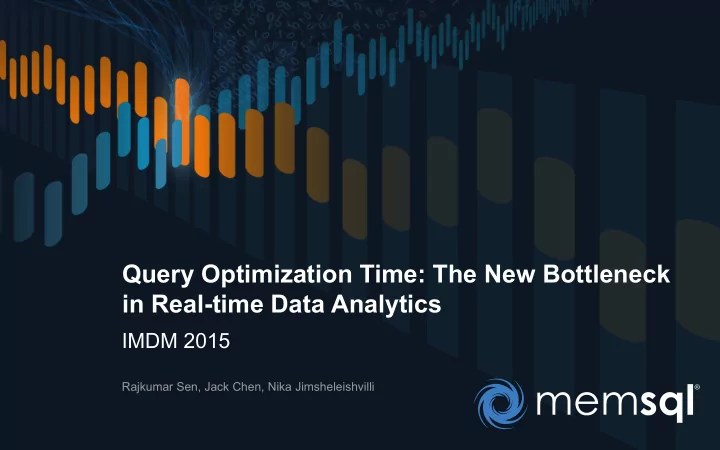

Query Optimization Time: The New Bottleneck in Real-time Data Analytics IMDM 2015 Rajkumar Sen, Jack Chen, Nika Jimsheleishvilli
Problem Statement 2
In-memory distributed databases everywhere.. What do we expect from in-memory today? • OLTP Improve transactional throughput • Ingest more per second • • OLAP Load data faster • Generate reports faster • Enable real-time data analytics • 3
Real-time Data Analytics Today § Answer analytical queries in “real-time” • within a second or few second, not minutes § Data mostly in the ~100s TB range § Demands query execution to finish within a second or few seconds § Queries could be ad-hoc (analytical dashboards) § Queries could be complex • A few joins (star or snowflake schema) • Groupby, Aggregates • Sub-queries 4
Example Query 1: Big Financial Services § Distributed Join Order, Outer Join to Inner Join rewrite SELECT ….. FROM REFERRAL T1 LEFT OUTER JOIN REFERRALASSIGNMENT T2 ON T1.REFERRAL_ID = T2.REFERRAL_ID LEFT OUTER JOIN ENTITYTOEXTERNAL T3 ON T1.REFERRAL_ID = T3.ENTITY_KEY AND T3.RELATIONSHIP_TP_CD = 1000008 AND T3.RELATIONSHIP_OWNER = 'R' LEFT OUTER JOIN APPOINTMENT T6 ON T6.APPOINTMENT_ID = CAST(T3.EXTERNAL_REFERENCE_KEY AS DECIMAL(10, 0)) WHERE T2.ASSIGNED_TO_CO_CC_NO = '00342|3425352' AND T6.START_TIME >= '2014-07-02-07.00.00.000000' AND T6.END_TIME <= '2014-07-03-06.59.59.000000’ 5
Example Query 2: TPC-DS Q25 (Simplified) Distributed Join Order, Bushy Joins SELECT .... FROM store_sales ss, store_returns sr, catalog_sales cs, date_dim d1, date_dim d2, date_dim d3, store s, item i WHERE d1.d_moy = 4 AND d1.d_year = 2000 AND d1.d_date_sk = ss_sold_date_sk AND i_item_sk = ss_item_sk AND s_store_sk = ss_store_sk AND ss_customer_sk = sr_customer_sk AND ss_item_sk = sr_item_sk AND ss_ticket_number = sr_ticket_number AND sr_returned_date_sk = d2.d_date_sk AND d2.d_moy BETWEEN 4 AND 10 AND d2.d_year = 2000 AND sr_customer_sk = cs_bill_customer_sk AND sr_item_sk = cs_item_sk AND cs_sold_date_sk = d3.d_date_sk AND d3.d_moy BETWEEN 4 AND 10 AND d3.d_year = 2000 6
Query Optimization Frequency § Ad-hoc queries from analytical dashboards always require optimization § Queries that are not ad-hoc may also require optimization • The first invocation of the query • If the data statistics have changed significantly • If the query parameters differ from previous invocations 7
Why is optimization time important? § Query Optimization time cannot afford to be the bottle-neck in real-time analytics § Very small time budgets (<100ms) for query optimization § Optimizer still should be able to produce efficient execution plans with near-optimal runtime performance Query Optimization has the potential to become the bottleneck in real-time analytics 8
MemSQL Query Optimizer 9
Overview of MemSQL § Fully distributed in-memory database system § Supports both OLTP and OLAP workloads § Extreme performance on commodity hardware § Designed for infinite scale-out § Two-tier architecture; scalability on every tier Agg 1 Agg 2 Leaf 1 Leaf 2 Leaf 3 Leaf 4 10
MemSQL Query Optimizer § A modular and flexible query optimizer § Built from scratch using a lot of C++ lambda functions § Three principal components • Rewriter • Enumerator Rewriter • Planner Planner Enumerator 11
MemSQL Query Optimizer § Rewriter: • Applies query rewrites based on heuristics or cost; • Costs rewrites by calling the Enumerator • Interleaves mutually beneficial rewrites § Enumerator • Join order based on distributed cost • Data movement decisions (e.g. broadcast, reshuffle) § Planner • Converts the chosen logical execution plan to a sequence of distributed query and data movement operations. 12
Where does the optimizer spend time? § Time consuming components need to be dealt with efficiently and intelligently § Cost-based query rewrites § Join enumeration to choose best join order • Generating bushy join plans § Distributed join order • Search space analysis 13
Reducing Query Optimization Time 14
Generation of Bushy Plans outside Enumerator § Considering all bushy joins in join enumeration is extremely expensive § However, bushy joins are critical for execution performance • E.g. several TPC-DS queries benefit by 3-10x § Consider only promising bushy joins instead of all possible cases § Look for common query shapes that benefit from bushy plans and introduce bushiness via query rewrite 15
Extremely Fast Enumeration § Prune heavily to eliminate a huge majority of the search space § Enumerator uses several heuristics to generate initial candidate join orders; • Cost each candidate join order • Cheapest candidate provides an initial upper bound on the cost § Details are in the paper 16
Some Experimental Results 17
Optimization time for TPC-H Queries Query Tables Time (ms.) Q3 3 5.09 Q5 6 9.99 Q7 6 5.94 Q8 8 20.7 Q9 6 6.36 Q21 6 11.02 Minimal optimization time for most queries 18
Pruning Percentages for TPC-H Queries Query Tables Pruning % Q3 3 25.00% Q5 6 61.46% Q7 6 72.92% Q8 8 95.80% Q9 6 84.90% Q21 6 62.50% Pruning percentage huge for most queries 19
Bushy Join Speedup and Overhead for TPC-DS Query Optimization Overhead Execution Speedup Q15 13% 5.8x Q25 16% 10.1x Q46 12% 2.85x Significant execution speedup with minimal optimization overhead 20
Current Work 21
Work in progress.. § Parallelizing the join enumeration process § Refine heuristics based on knowledge from customer experiences § Getting the costing “right” 22
Q & A 23
Thank You www.memsql.com
Recommend
More recommend